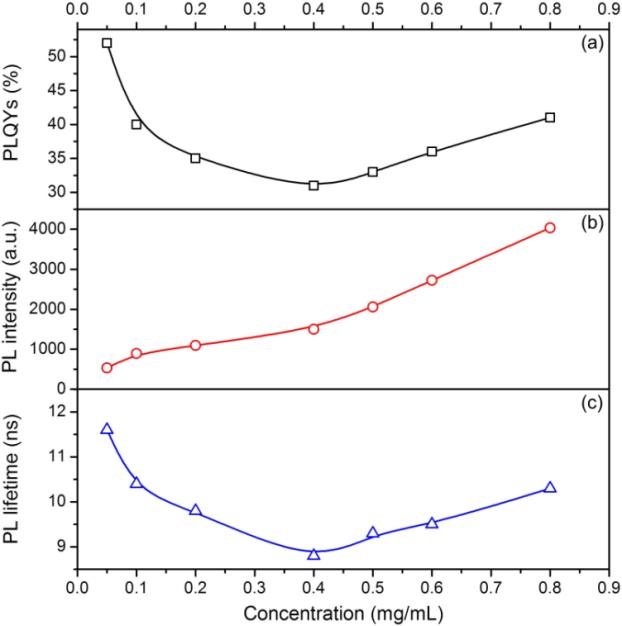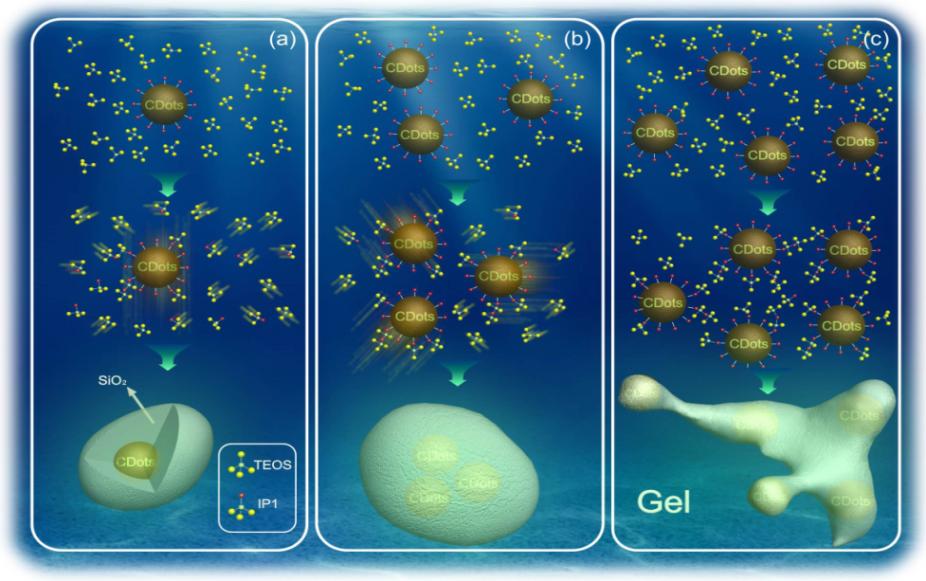Author: |
Recently, Professor Songnan Qu and his team at CIOMP have developed strongly luminescent CDots at silica composite gels with highly concentrated emitting centers, where the gelation of tetraethyl orthosilicate is initiated by the surface hydroxyl groups of CDots. The key feature of this approach is to prevent both the collision between high concentrated CDots in gelating solution and their aggregation upon drying.
The resultant CDots at silica composite xerogel exhibits both high CDots loading fraction (19.2 wt%) and photoluminescence quantum yields (>40%). The advantage of the resultant composites is conquering aggregation-induced solid-state luminescence quenching of carbon dots and its superior resistance toward UV light irradiation. These merits allow for the fabrication of CDots-based light-emitting diodes using the CDots at silica composite xerogel as a color conversion layer. This work was published in Chemistry of Materials (First author: Ding Zhou) and supported by National Natural Science Foundation of China, the Outstanding Young Scientists Program of Chinese Academy of Sciences, the Program of the Young Scientific and Technological Innovation Leader and Team in Jilin Province, and Project supported by State Key Laboratory of Luminescence and Applications.

Figure 1. Variations of (a) PLQY (open black squares), (b) PL intensity (open red circles), and (c) PL lifetime (open blue triangles) of the CDots at silica composites versus the concentration of CDots ethanol solution. Solid lines are solely provided as a guide to the eye. (Image by CIOMP)
Luminescent carbon dots (CDots) possess distinctive merits, such as excitation-dependent luminescence, low cost, chemical inertness, low cytotoxicity, high photostability, and excellent biocompatibility. These advantages inspired extensive studies on CDots, which have already resulted in several applications in various fields, such as CDots-based bioimaging and their use as fluorescent inks. Recently, CDots-based solid-state luminescent composites have received increased attention, as they are promising fluorophores for carbon-based light-emitting diodes (LEDs). However, one of the obstacles in realizing efficient CDots-based phosphors is their aggregation-induced luminescence quenching, which can seriously deteriorate their photoluminescence quantum yields (PLQYs) in the solid state. Esecially, high PLQYs of CDots-based solid-state luminescent composites are rather difficult to realize for high CDots loading fractions.

Figure 2. Schematics of the Formation of CDots at Silica Composite Nanoparticles/Gel at (a) Low, (b) Medium, and (c) High Concentration of CDots Ethanol Solutions.
(Image by CIOMP)
In order to achieve the aim, researchers have employed CDots prepared using citric acid and urea with plenty of hydroxyl groups on their surfaces, being able to form links with gelating silica. Gelation reaction between tetraethyl orthosilicate (TEOS) and CDots at relatively high concentration (0.8 mg/mL) efficiently restricts collisions between CDots, resulting in well-separated emitting centers distributed in formed xerogel, with both high CDots loading fraction (19.2 wt %) and high PLQY (41%). By virtue of this strategy, blue and green emissive CDots at silica composites can be prepared, and possess superior resistance toward UV light irradiation. These advantages permit the fabrication of CDots-based LEDs with Commission Internationale de L’Eclairage (CIE) coordinate, (0.33, 0.34); color temperature, 5603 K; color rendering index, 79; and luminous efficacy of radiation, 28 lm/W.

Figure 3. Photographs of the CDots at silica composite gel taken under sunlight (panels (a1) and (a3)) and UV light (panels (a2) and (a4)). After freeze-drying the gel, CDots at silica composite xerogel is obtained, with the PL emission spectrum (panel (b)) taken at 375 nm excitation and a photograph taken under UV light in the inset (panel (c)). An SEM image (panel (d)) and a TEM image (panel (e)) are also shown.(Image by CIOMP)

Figure 4. (a) Photograph of the xerogel-PDMS composites excited by an ultraviolet lamp. (b) Emission spectrum of a down-conversion white LED prototype entirely based on a powdered CDots@silica composite xerogel with a photograph of the working device (inset, panel (c)). (Image by CIOMP)
Contace:
QU Songnan, +86-0-18943971776
Author email: artqusongnan@163.com
Article link: http://pubs.acs.org/doi/abs/10.1021/acs.chemmater.6b05375
